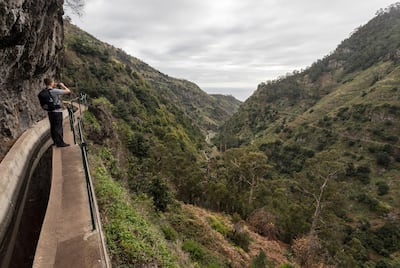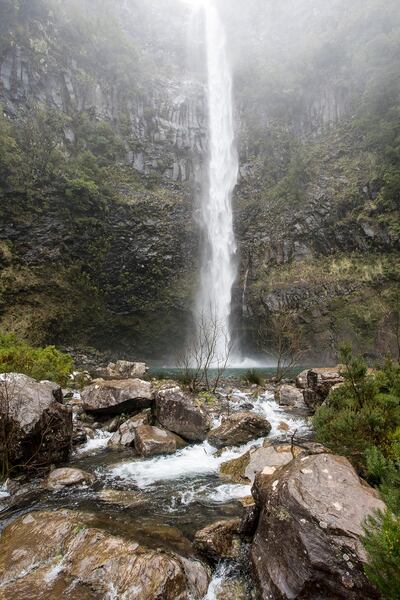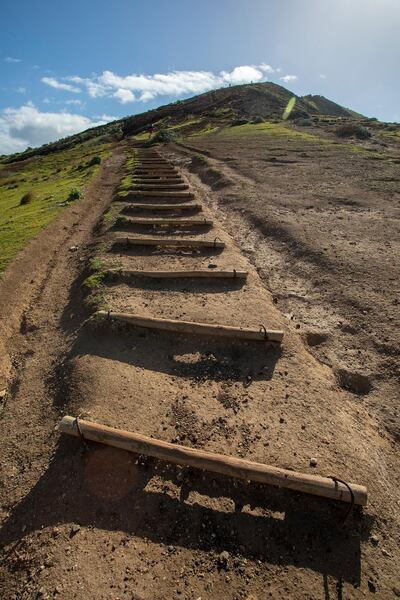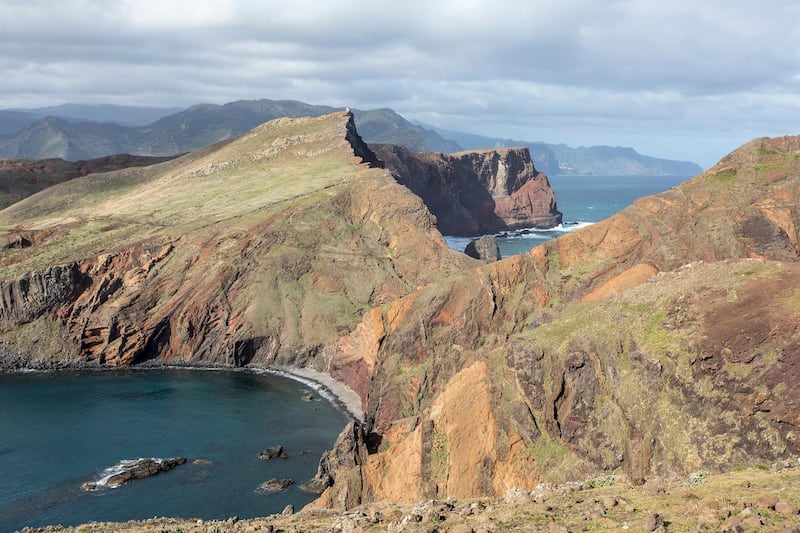The seabirds make a mockery of the gales. While everyone else struggles in the howling wind, the stronger the Atlantic gusts, the more perfectly they fly. I'm trekking out to the end of Ponta de São Lourenço, the eastern most tip of Madeira, the Portuguese island-chain approximately 580 kilometres west of Morocco. This is to be the first of many hikes over a long weekend, but while the rest will follow routes in the mountainous interior, out here, the treeless 7km return journey is, quite literally, shaped by the sea.
The peninsula seems to have a sort of geological arthritis – all bumps and sharp twists. Two uninhabited islands rear up just off its end point, looking as though they’ve been snapped off from the headland and cast adrift. Further from shore, fierce winds lash at the surface of the eerily placid ocean.
The whole thing looks new, which is to say it has not been smoothed by time. Instead, jagged cliffs reveal psychedelic strata thrust skywards from the seabed by extraordinary volcanic violence over the millennia. An hour-and-a-half into the walk, I’ve reached as far as I can go, the top of the hill, with sensational views in every direction. To the north I can see the islands of Porto Santo, while to the south the cliffs of Ilhas Desertas (The Deserted Islands) are being harangued by a distant storm.
Standing there feels like a pure sort of coastal experience, and initially, I suspect that all the hikes will have this sort of abrasive, salty atmosphere. A couple of hours later, however, I’m standing ankle-deep in snow on a mountain. On Madeira, everything – landscape, weather, flora and fauna – can change very quickly.

Of all the old colonial islands of the North Atlantic, Madeira perhaps has the most geriatric reputation – if you want to party, head to the Canaries; if you want sandy beaches, check out Cape Verde. Madeira is the place to come if you want peace, quiet and winter sun. In some ways, it’s also a terrible place for walking. In and around Funchal, the largest town on the island, the streets are so steep that even locals prefer to take a car. Above their heads, gondolas ship others to higher neighbourhoods.
Because the topography rises so severely from the ocean, almost all treks other than Ponta de São Lourenço start at significant elevation. While there are ascents and descents, if you hit the snowbound peak of Pico Ruivo, as I have, you will likely have begun your peregrination well above sea-level.
For this particular trek, I've followed the excellent WalkMe app's instructions to the start point over 1,500m in the sky. I may have driven to get there, but even that wasn't easy. Madeira's roads are such, that if you drive yourself, you need to do so confidently, even boldly, in a car with manual transmission – the smaller the better. Nowhere have I ever driven in first and second gear so frequently, nor said quite so many prayers when wrenching my handbrake.
At 1,861m above sea level, Pico Ruivo is the highest peak anywhere in Madeira. On clear days, you can see both sides of the island, north and south, the vastness of the Atlantic stretching infinitely beyond. Today is not one of those days. Instead, at the peak there’s snow underfoot, and past that a great, grey void of cloud. Bringing a flash of colour, a pair of fat gold finch soon arrive like plump bouncers, demanding food as some kind of entrance fee to their lofty home. One is even bold enough to fly right in my face when I don’t accede to its demands.
Rough-hewn coasts and snowy mountain tops are two of Madeira's features, but they're rarities compared to the islands' innumerable waterfalls. Puffy clouds travel across the Atlantic before snagging on peaks like Pico Ruivo and bursting. From there it's a long way back to the ocean, and the waterfalls are so abundant that the island looks as though it's perspiring.

The largest falls make for natural goals and some of the most memorable treks. The following day I consult WalkMe again. It's hard to overstate the usefulness of the app, which has been specifically designed for Madeira. It allows users to search walks by distance, difficulty, and style (round-trip, point-to-point, return journey). It also gives driving directions to the start of each trek, and then tracks your progress while you're actually doing them. It isn't quite perfect – on the Levada do Moinho trek it suggests I walk further than I need to, and for the Caldeirão Verde, it sends my car in the wrong direction entirely. But still: I see more of the island and do more walking because I have the app to guide me. In total, I rack up almost 50km in just four days. Each night, I return to the sprawling Belmond Reid's Palace to soak my weary feet in a bath to soothe them. The historic hotel has been open since 1891.
The app also allows users to review each trek. One of the most highly-rated is Lagoa do Vento, a 6.7km loop which is graded as “hard”. Like so many Madeiran walks, it starts by following a levada, a man-made irrigation channel that transports water around the island. If the waterfalls are Madeira’s arteries, then these levadas are its capillaries – narrower, more abundant and less dramatic. The wild changes in weather may be remarkable to tourists, but for the early settlers here, while one side of the island was often drenched, the other would be parched. The levadas became an aqueduct system to cure this imbalance, and today, there are
over 2,100km of them, still very much in use, criss-crossing though the mountains.
_______________
Read more:
My Kind of Place: Belém, Lisbon, Portugal
Smart Shopper: Lo and behold Lisbon
My Kind of Place: Lagos, Portugal
My Kind of Place: Tavira, Portugal
_______________
The labour required for their construction must have been superhuman, but while they provide vital resources for Madeirans, they also provide routes for trekkers, too. For the first hour of the route to Lagoa do Vento, I plan to follow Levada do Alecrim, the rosemary waterway.
I’m in the western part of the island, in the area known as Rabaçal. WalkMe lists three hikes starting from the same car park, but Levada do Alecrim soon has me leaving that behind to enter a world of green. All the moisture fuels one of the most verdant landscapes I have ever seen, when I can see anything at all – alongside the levada, the foliage often forms a tunnel. I quite literally cannot see the woods for the trees.
An hour or so after starting, the path veers off to the left, away from the levada, leading me down for 20 minutes or so, along a mulchy path into even denser forest. It then forks, the right branch leading to Lagoa do Vento, this trek’s prize. Left will, after several hours more effort, finally get me back to the car.
I plunge down the steep steps to the right, a little concerned about how much effort will be required to make it back up again, the jungle getting thicker as I descend. Lagoa do Vento means Wind Lagoon, but the place is actually quite sheltered. That’s not to say it is not windy – the mighty Risco Waterfall tumbles down into the plunge pool with such force that it generates its own breeze. At around 100m tall, it’s so high, that on a misty day like this, the water seems to be falling directly from the sky.

It’s one of those scenes that looks almost manmade, too perfect to have been created by natural chance. But perhaps that thinking is wrong-headed – the levadas had been manmade and were functional but a little ugly. Perhaps it’s better to leave things to nature – so long as we can follow a path there for a little peek.





